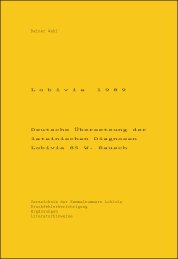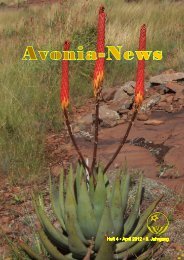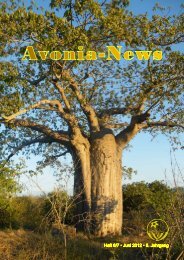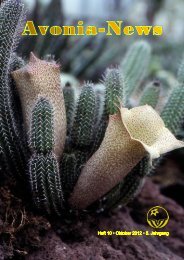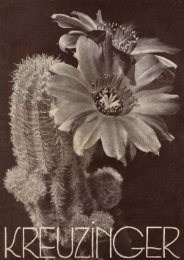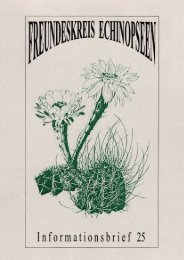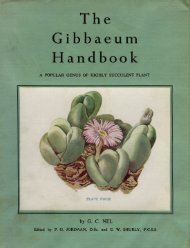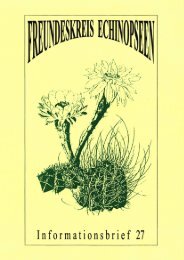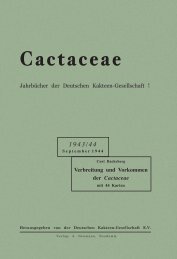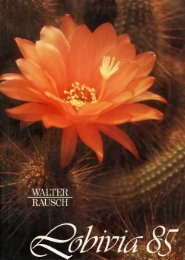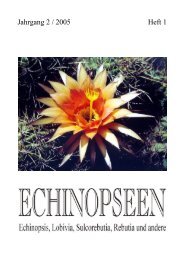VOLUME 14 :: January—October, 1952 Illustrations shown in ...
VOLUME 14 :: January—October, 1952 Illustrations shown in ...
VOLUME 14 :: January—October, 1952 Illustrations shown in ...
You also want an ePaper? Increase the reach of your titles
YUMPU automatically turns print PDFs into web optimized ePapers that Google loves.
20 THE CACTUS AND SUCCULENT January, <strong>1952</strong><br />
At the time of writ<strong>in</strong>g I have only had one reply to my appeal for news of other aquatic succulents. Mr. Gordon<br />
Rowley sends me a copy of a mention of Rhopalota aphylla N. E. Br. (Crassulaceae), which appeared <strong>in</strong> the American<br />
Cactus Journal on pages 7 and 8, 1931. It reads : "A very dwarf, leafless annual, with articulated stems like a<br />
m<strong>in</strong>iature plant of Hariota. It grows beneath n<strong>in</strong>e <strong>in</strong>ches of water and is frequently covered by ice <strong>in</strong> the w<strong>in</strong>ter,<br />
but apparently flowers only when the water level drops and the branches are exposed."<br />
This is not quite the same as Chamaegigas which throws leaves and flowers while covered with water, but it<br />
is a very <strong>in</strong>terest<strong>in</strong>g addition to our knowledge of this type of succulent plant. Mr. Rowley's extract is from a much<br />
longer article by Dr. N. E. Brown and <strong>in</strong>cludes a draw<strong>in</strong>g of this plant.<br />
I aga<strong>in</strong> appeal to all our friends <strong>in</strong> South Africa and elsewhere to furnish us with details, and samples if possible,<br />
of any other plant that justifies the name of aquatic succulent, for this is a phase of our subject that has been very<br />
neglected and would add change and <strong>in</strong>terest to our collections.<br />
I have already mentioned that I was unsuccessful <strong>in</strong> cultivat<strong>in</strong>g the plant, but I could make some comments on<br />
what I saw. I received a piece of South African veldt about two <strong>in</strong>ches square and about a quarter of an <strong>in</strong>ch thick.<br />
This conta<strong>in</strong>ed more than a dozen of the plants. The upper surface of the piece of ground was covered by dead,<br />
short, gray grass ; the soil was of a very sandy nature and a separate sample of soil sent me is made up of very<br />
f<strong>in</strong>e sand, some larger types of sand, like f<strong>in</strong>e gravel, a small mixture of f<strong>in</strong>e textured soil and quite a bit of humus<br />
<strong>in</strong> the form of whitish grey rema<strong>in</strong>s of short grass. Here and there gl<strong>in</strong>ts t<strong>in</strong>y pieces of quartz-like substance.<br />
Obviously the soil is extremely porous and must absorb ra<strong>in</strong> very fast <strong>in</strong>deed and this may be the cause of my failure.<br />
In its native habitat the soil quickly gets thoroughly wet and so reaches the whole of the bulb almost at once, but<br />
the piece of veldt I received was very matted and it is possible my submerg<strong>in</strong>g under luke warm water may not<br />
have penetrated to the bulbs.<br />
The bulbs 1 measured with a magnify<strong>in</strong>g glass and metre rule. They were one mm. <strong>in</strong> diameter, roundish to<br />
slightly pear shape, green, with short wavy roots. The presence of the bulbs was <strong>shown</strong> on the surface of the soil<br />
by the rosette-like rema<strong>in</strong>s of old leaves, or, more probably, the stems.<br />
I hope that I may have the chance of aga<strong>in</strong> try<strong>in</strong>g to cultivate the plant through to its flowers, for one can only<br />
echo D<strong>in</strong>ter's comment that it is the most touch<strong>in</strong>g example of the victory by one of her children over Nature's<br />
apparently pitiless fight. Aga<strong>in</strong>st extremely hot conditions dur<strong>in</strong>g its rest<strong>in</strong>g period, months of completely arid<br />
conditions, the bulb is able to reta<strong>in</strong> stored sufficient nourishment to ma<strong>in</strong>ta<strong>in</strong> life, even though dur<strong>in</strong>g dormancy<br />
it does not absorb anyth<strong>in</strong>g near as much as dur<strong>in</strong>g its liv<strong>in</strong>g period, then when the shallow bas<strong>in</strong> <strong>in</strong> which it grows<br />
becomes covered with water, its quiescent life jerks <strong>in</strong>to action <strong>in</strong> a few m<strong>in</strong>utes, and one day after it flowers !<br />
The bulb rema<strong>in</strong>s under water, sends out thread-like stems which term<strong>in</strong>ate on the surface of water, like water<br />
lilies, with leaves. In its native habitat ra<strong>in</strong>s may not appear for much longer periods than those mentioned <strong>in</strong><br />
the extracts given above, yet the plant lives on. Frequently the ra<strong>in</strong>s are short lived and its life cycle has to be<br />
completed <strong>in</strong> possibly a very few days, then to return to its rest<strong>in</strong>g period for another ra<strong>in</strong>fall.<br />
If this does not typify "the bravest th<strong>in</strong>g that grows," then I should like an <strong>in</strong>troduction to a plant that is<br />
braver. While D<strong>in</strong>ter comments on Nature's pitiless struggle aga<strong>in</strong>st her children, we must credit Nature with<br />
evolv<strong>in</strong>g adaptions of plant structure that this, one of her children, can withstand the conditions and live and flower<br />
and reproduce its k<strong>in</strong>d.<br />
Frames Tours Ltd. are runn<strong>in</strong>g a very <strong>in</strong>terest<strong>in</strong>g tour cover<strong>in</strong>g the dates February 16th to March 1st, or March<br />
1st to 15th and March 15th to 29th. The tour covers extensive ground and is of special <strong>in</strong>terest to all <strong>in</strong>terested<br />
<strong>in</strong> horticulture with a special <strong>in</strong>terest to our plants. It covers San Remo, Monaco, La Mortola, Grasse, Cannes,<br />
Genoa. Members <strong>in</strong>terested should write Messrs. Frames, direct.<br />
Lists received :<br />
T. N. Blackburn, Woodplumton, nr. Preston ; a five-paged priced list of cacti and succulents.<br />
A. E. Green, Normandale Nurseries, Sheffield, 6 ; a three foolscap paged typed list of cacti and succulents.<br />
F. Jansen, Leyweg, 24, Loosdu<strong>in</strong>en, Holland ; a four-paged priced list of cacti and succulents.



